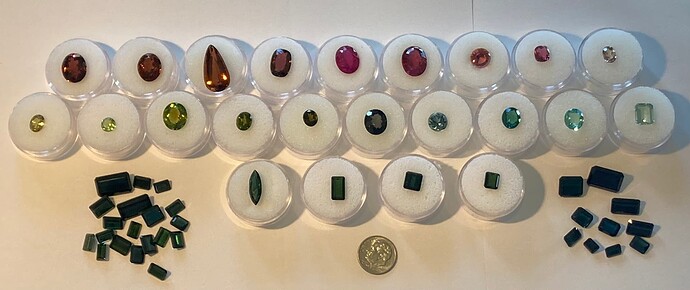I wish my photography skills could capture the beautiful array of colors among my inherited collection of Tourmalines. The paper packets they arrived in help with identifications, but I’m learning so much about these stones that I now realize that saying “Tourmaline” is just the beginning. Rubellite, Indicolite, Paraiba, Chrome, etc. oh my!
In this picture, the top row, from left to right, has three that are referred to as “Brandy”; the next next six are shades of pink with two specifically labeled "Rubellite (the 5th & 6th from left); the second row has yellow and green up to the 6th stone that is either dark grey or light black; after that is one labeled “steel blue” then come the three I believe could be called Paraiba; and then the bottom collection are Indicolite? The cluster on the left are more of a green variety, and the cluster on the right show flashes of blue, and the four in the middle of the two clusters read blue and green in such equal proportions that I’m having a hard time nailing down a solid description.
Not photographed are several dozen of the Indicolite (?) variety that are so dark that it’s pointless to try to photograph them; they look black in pictures even though I see blue and green when I hold them up to a light.
I’m doing my best to itemize all of these in the hopes of eventually selling them, so their identifications will be important. The dark grey/light black stone is surprisingly attractive, but it would be a stretch to call it purple.
I’ve also come to understand that “native cuts” represent a minimal amount of faceting, and I think many of these stones fall into that category.
Any additional thoughts about Tourmalines from the IGS community or comments about this particular array of stones would be welcomed and much appreciated.
Be very careful with the appellation “paraiba.” Strictly in the gemological community only neon tourmalines from the Paraiba area in Brazil are to be called that. One establishes a provenance and that determines the (very high) value, which I think is nuts, because you are basically taking someone’s word that this comes from Paraiba. AFAIK the mines are all played out now, so there is a limited supply. Stones with those colors from other parts of the world are also high priced, tho’ not as high, and are designated “copper bearing” after a lab exam, so you need a cert from a reputable lab.
Tourmaline is a fascinating stone because of the dichroism and the many, many colors. However, unless it is of large size (3+ ct) and prime color with few inclusions and no brown or gray in the color, is is seldom worth a lot of money. An on line search of reputable retailers will tell you something about approximate prices. Usually in the $50-$100-$150/ct range. Lately tourmaline rough asking prices have been ridiculously high, but cut stones don’t reflect this…you can see the rough going for $100+ per gram and the cut stones for sale for less than that, which makes absolutely no sense. Enjoy your collection and good luck with any sales. -royjohn
Thank you Royjohn for your words of caution regarding the “paraiba” lable. I was under the impression that, at this point, “paraiba” had more to do with that vivid swimming pool green/blue color than where the stone was from. After searching “paraiba,” I see that the particular mining region in Brazil, Paraiba, discovered this mineral in the 1980’s, and since my stones all appear to have been collected in the 1960’s and '70’s, it’s unlikely that they came from Paraiba, Brazil.
